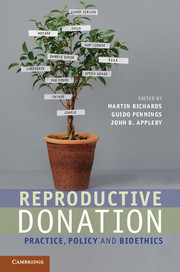Book contents
- Frontmatter
- Contents
- Contributors
- Acknowledgements
- 1 Introduction
- 2 The biology of donation
- 3 Ethics for reproductive donation
- 4 Parenthood – whose right is it anyway?
- 5 Reproductive donation
- 6 UK and US perspectives on the regulation of gamete donation
- 7 Gamete and embryo donation
- 8 The legal and ethical regulation of transnational donation
- 9 Balancing ethical criteria for the recruitment of gamete donors
- 10 Challenges in intra-family donation
- 11 ARTs and the single parent
- 12 Reproductive donation and justice for gay and lesbian couples
- 13 Is disclosure in the best interests of children conceived by donation?
- 14 Identifiable donors and siblings
- 15 Ethical issues in embryo donation
- 16 Reproduction through surrogacy
- 17 Some conclusions regarding the interaction of normative and descriptive elements in reproductive donation
- Index
- References
16 - Reproduction through surrogacy
The UK and US experience
Published online by Cambridge University Press: 05 August 2012
- Frontmatter
- Contents
- Contributors
- Acknowledgements
- 1 Introduction
- 2 The biology of donation
- 3 Ethics for reproductive donation
- 4 Parenthood – whose right is it anyway?
- 5 Reproductive donation
- 6 UK and US perspectives on the regulation of gamete donation
- 7 Gamete and embryo donation
- 8 The legal and ethical regulation of transnational donation
- 9 Balancing ethical criteria for the recruitment of gamete donors
- 10 Challenges in intra-family donation
- 11 ARTs and the single parent
- 12 Reproductive donation and justice for gay and lesbian couples
- 13 Is disclosure in the best interests of children conceived by donation?
- 14 Identifiable donors and siblings
- 15 Ethical issues in embryo donation
- 16 Reproduction through surrogacy
- 17 Some conclusions regarding the interaction of normative and descriptive elements in reproductive donation
- Index
- References
Summary
Introduction
From its beginnings, surrogacy has been dogged by controversy. Even the terminology has been met with controversy (English et al., 1991). In the United Kingdom arrangements where the surrogate is also the genetic mother of the child have been defined as ‘partial’, ‘straight’ or ‘genetic’ surrogacy, and arrangements where the surrogate is not genetically related to the child have been called ‘full’, ‘host’ or ‘gestational’ surrogacy.
In the United States surrogacy originally described an arrangement in which intended parents attempted conception through the use of a woman’s egg, and that woman underwent inseminations with the intended father’s sperm. In this case the surrogate was providing both the genetics and the gestation. As in vitro fertilization emerged as a viable treatment option, another surrogacy option emerged wherein a couple or individual worked with a woman who would carry a genetically unrelated embryo that was transferred to her. In this scenario the surrogate contributes only the gestation. In 2006 1 per cent of all fresh ART cycles in the United States involved a gestational surrogate (for a total of 1,042 cycles); additional cycles were performed involving donor eggs (CDC, 2006). In the UK the number of surrogate births, although rising, is harder to estimate due to a number of more informal home-insemination arrangements. In this case IVF is not required and so the surrogate birth goes unregistered as such.
- Type
- Chapter
- Information
- Reproductive DonationPractice, Policy and Bioethics, pp. 289 - 307Publisher: Cambridge University PressPrint publication year: 2012
References
- 5
- Cited by



